

Sail Trim (Jim's learning to date) for a Gemini 105
I have been posting in pieces my learning about sail trim and using a snatch block on my website. In addition, I made the statement that every Gemini owner should have a snatch block on their boat. So, I received an email from Brian, who also owns a Gemini 105, who wanted to know how to use the snatch block and more importantly, why it worked. I decided that I would probably learn something by actually writing this so if you don't like it, blame it on Brian. (Just kidding, send me an email and I will learn more!) First, I have to go back to Georgetown and talk about what I learned at the sail trim seminar I went to. Tip one - The front edge of the sail should be set parallel to the wind. To me this was very important, if the wind is coming from the beam then you can quickly set the sail with either the main sheet or jib sheet so the leading edge is parallel to the wind. HOWEVER, it won't be trimmed. Tip two - Shape the
sail. Based on this information, I went back to the Gemini and decided that I had lots of options for the main but only one option for the jib. The jib is a problem because of the location of the track and it is really only good for a wind of about 60-80 degree wind. You don't have choices for a wind that is closer than 60 degrees and you really don't have the right sail shape for 90 or more degrees. (I know, this is a bold statement but I really believe it is true. I will show you why below.) |
|
Less than 60 degrees - I have never been able to get the jib to fly in less than 60 degrees of wind. Ok, when that happens I am typically motor sailing but having that sail up front should help me and I hadn't been able to figure out how. Let me start by saying I have hull number 536 and at the base of the mast is a very rugged piece of stainless that I can tie a snatch block to. I rerun the jib sheet inside of the stays and then let out approximately 12-15 feet of the roller furling line and I now have a small jib. In the picture to the right, you can see how I have the snatch block attached. It is tied to the base of the mast and I can't even imagine how you can get the jib to fly using the mid track on the Gemini at this wind angle. You are probably thinking right now that this is a roller furling jib and the shape isn't perfect. So what! I pick up about .4 knots, in about 15 knot winds, when I do this and in anybody's world, that is significant going to the weather such as when we motor sailed across the gulf stream at 30 degrees to the wind taking a wave over the front of the boat every 3 waves. NOTE: In the picture to the right, we are motorsailing at about 25-30 degrees to the wind and could not fall off or we wouldn't make a point we needed to make. |
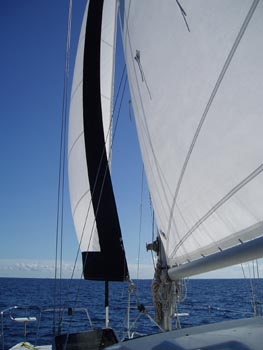 |
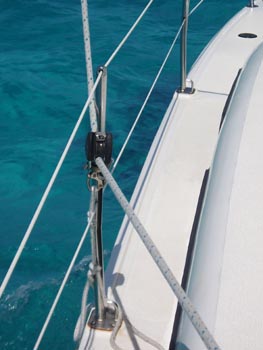 |
90 degrees or above - At this point, I find the the tack of the sail (the end the jib sheet is attached to,) is inboard too much IF you actually pull it tight enough to get the top of the sail to fly correctly. What we are looking for is the angle of the luff of the sail (aft portion) is the same as the main's luff from the top of the sail all the way to the bottom. If this is the case, then you will sail faster because the sail is trimmed properly and both sails are working together creating the slot. I sailed for years, and I will admit I am not a true sailor. Previously, I thought I was doing well with our sail speed. HOWEVER, I have picked up another half or slightly more knot of speed since I have changed the location of the block controlling the jib. Now you may be asking, is the stanchion strong enough to handle this? I asked the same thing of Will at Performance Cruising and he said - "Hi Jim - Thanks Will! When Will saw this picture he asked that I make sure that you understand that I am tying the snatch block to the base of the stanchion. I hope you can see that in the picture! Below you can see the angles of the sails and how using the snatch block allows me to pull the sail down while keeping the tack out. The result is the combination makes a great slot. The picture to the left shows the angle of the jib sheet and the fact it is pulling downward. The picture to the right is a better shot of the slot between the sails. It also shows the relative position of the two sails and how they appear to be very similarly shaped. |
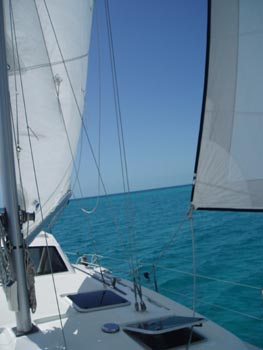 |
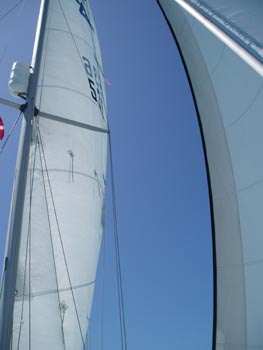 |
So to further the theory portion, I have always been able to trim the lower portion of the sail but I was never able to pull down the top and also keep the bottom in trim UNTIL I added a snatch block to my sail trim inventory. This has caused me to begin thinking about how to add a track to the outboard portion of the boat. I expect I will do this during hurricane season this summer when I am making boat upgrades for the next sailing season. I have one final lesson I've learned and that has to do with wing on wing sailing. There are actually two things I have learned. First is one I haven't done yet but plan on next sail out. I will be running a line to one of the reefing rings under the mast, run it under the stanchion and then pulling the boom down to flatten the sail. This will allow it to catch more wind on the down wind run. This will also serve as a preventer. (Yes, I use one already.) The second lesson is also two fold. First, I have moved the snatch block further aft and sometimes as far back as the aft cleat to get the jib to fly full. The second is that in light winds, the two jib lines will collapse the jib. Therefore, I carry a 1/4 inch line to use as a jib line in these conditions. I simply untie the two large jib lines, tie on the 1/4 inch line and let it fly. It will fly instead of collapsing under the weight of the two large lines. |
|
I am still learning about sail trim and would truly appreciate any feedback pro or con so I can try it out and modify this information. Jim |
And we received feedback! THANKS! See below. |
| Hi Jim, I
have been using the snatch block attached to the stanchion bases for Bill Schardt, #892 |
Thanks Bill. I hope you find it works as well as I have. |
| Hi Jim A
great explanation and pictures. These are all the same techniques we |
Richard, it is good that what I learned is in fact used on other boats! |
| Another trick is when
your running real deep (not wing and wing) and the jib is starting to collapse, take the jib sheet and just put it around the end of the boom. No blocks, no hassle. It really opens up the jib. We
used that trick under the old racing rules that forbid you having a Rick |
Rick, What a GREAT idea! I will try that. I have had a problem keeping the jib flying when I'm sailing at 120 or so degrees. I don't have a spinnaker pole so this should help. When the wind cooperates, I will be sure to get pictures. |
| Hi Jim, Good
discussion on sail trim. A look at real race boats will show they I also have used the
snatch block on the screecher when the wind moved Going Wing and Wing
in light air, I also discovered I could run the jib A friend who always
sails faster than me gave me one hint for moderate A couple of comments
of your web page wording to make it more Cheers, --Don 777 |
Don, Thanks for the feedback. I'm thinking I will add that second track on the toe rail this next summer. Of course when I do, I will have pictures. What I want to do is to do some more sailing when we get to Key West to decide exactly where to put it. I think I mentioned running the jib sheet rearwards along with even changing the jib sheet out to 1/4 inch in light wind. You are right, it works. I also found that looping it works well or I bring it around the cleat and back up to the cleat that is next to the wheel and just wrap it around a couple of times. I will try moving the jib fairlead back and sheeting in tighter. We are out cruising with a fairly loaded boat and we can always use extra help on going faster. Thanks for the instruction on the terminology. I will change the information above accordingly. Thanks again for the help! |
| Hi Jim, I
have been following your travels with Deb and it sure does help to I really do appreciate
the sail trim page. You had mentioned using Thanks for the great logs and photos! Dave Luther |
Good points Dave. The
snatch block is attached with a 4 foot line. If the wind is real close, say 30 degrees, I tie it close to the mast, in other words about a half a foot away. . If it is 40 degrees, I tie it about a foot and a half from the mast. Now on the stanchion, I tie it about foot and a half off the bottom of the stanchion and if I move it to the stanchion next to the wheel, I may tie it a full 3 1/2 feet (max from the bottom of the stanchion. In other words, just try and get the pull such that everything is flying.
|
| Jim, Sheeting
the jib in as tight as you show on the picture looks a bit over the But if I had 15 knot
winds 30 degrees off my desired course, then my Regards, Alistair Newton |
Alistair, Thanks for pointing out I need to label that picture. The one you are talking about is when we were going 25-30 degrees to the apparent wind. It does look too tight but that is where it flew and we picked up about .3 knots. I will have to take a picture when going 45 or so degrees to the wind. It is further out and looks much better. At the time this picture was taken, we were heading for south riding rock crossing the gulf stream. If we would have fallen off the wind, we would have to go all the way north and around Bimini. That would have taken an extra day or two. One of my purposes for showing this was to show if you have to get someplace, this could help. Thanks for the feedback. |
| Great to have you back! I've been avidly following your and Deb's Bahamian adventure for the past few months. It's certainly made a cold gray rainy Northeast Winter much more tolerable. I agree with you, varying the slot is one of the keys to sailing the Gemini. Here's a really interesting article on slot effect that give an interesting take on the phenomenon http://tinyurl.com/ysby9t If I'm reading him right, he's saying that the venturi effect, which suggests that air molecules miss their fellows cruelly once the sail luff has parted them, and rush across the lonely reaches of the curved sail to be reunited with them at the leech, is a somewhat strained metaphor. What pushes air through the slot is the boat's momentum, and the air's momentum (wind). If you set your sails right, when you're motor sailing close hauled, using the engine's power and the wind's power to push air through a narrow slot can create a high pressure area behind the jib. If the slot dynamics are right you can get a lift. The snatch block setup you 'invented' seems just the ticket for motorsailing close to the wind. It allows you to get lift from both the jib and main. By narrowing the slot you use both engine and wind power to increase pressure behind the jib, maximizing it's lift. By shortening the sail you minimize overlap, thus preventing high pressure area you created behind the jib from simultaneously becoming a high pressure area on the windward side of the main, creating drag. Since you're motoring, you also using engine power to cancel out the leeway the Gem usually develops on close hauled points of sail, thus increasing your VMG. Because of this main/jib interaction I think varying the slot on the Gem is an important part of sail trim. Unfortunately, the options are limited with the stock rig. I agree with you, on most points of sail it is impossible to get the top and bottom of the jib trimmed at the same time using the cabin top track. I've put Garhauer sheet leads on mine that are adjustable under load, and this helps, but doesn't solve the problem. I think the stanchions are usable as an alternative attachment point, but they're a stopgap measure. Even if they take the strain, as Will says they will, eventually they will leak because the flexing breaks the sealant loose. An outboard track, possibly augmented by a twing setup on the inboard track, seems like the way to go. One more thing. Because it has full battens, trimming the main is a learning curve on the Gem. Unless you're really stalling, the battens add rigidity and mask the leech luffing that would normally be your indicator of poor trim. To compensate for this you need a set of telltales about two feet behind the mast to tell you what the front of the main is doing. I bought a set of Davis stick on yarns last year, and put them in that very spot. They've helped me trim the main much better, and helped me get a better picture of the interaction between main and jib at various points of sail. Delighted to see more discussing about sailing the boat on the list. Mark Cetta #700 Mark, Thanks for the
wonderful input. I will have to get the telltails for my main and put
them 2 feet behind the mast. |
|
| Can you talk a little
about tacking with your block system - what are the steps involved? in particular what steps does the addition of the block add? I assume you only really use the blocks when you expect to be on the same tack for some while?. Same for reefing - what additional steps are involved? Finally,
a decent toe rail is really what I miss most on the Gemini. We Thanks for the tips Maryanne |
Maryanne, Right now I have one snatch block and I typically set it up when I have a long sail on one tack. This is what happened when we crossed the gulf stream and we were on the close tack for about 15 hours before we could ease. I simply ran the jib line inside of the stays and back to the winch. If I were tacking, I would have more work to do because I would have to rerun the line for each tach so that would mean I would have to go to the mast to change tack. If I was on a beam reach, then I would have to move it from stanchions to stanchions which is why I want to put on a track on a toe rail. I was over on another boat yesterday who had two blocks set up that he uses for his screecher and his jib. I'll put the pictures below.
|
| I tried this system,
attaching the block to the base of the stanchion just behind the winch, and it worked well in 2-10 knot winds--the kind that often stalled us. So, in this case, we sailed when we often would just turn on the engine in search of wind. It worked well on a broad reach and somewhat more downwind. Of course, the wind piped up to about 20 knots, as it always does around here, and I move the sheet back to the regular place. I
am not sure if I set it up properly, but when I pointed a little higher |
Andy, You've identified the reason I want to put the sail tracks on the outside of our boat on one of the "toe rails." At this point I think I'm going to put it between the 3rd and 4th stanchion but I am still going to have to test more before committing to it. You mentioned the jib sheet pressing down on the lifeline and I had the same problem. I raised my jib up understanding that my moment also raised. I had a stainless cable made that extended the jib up a foot. You will want to check how far up you can raise yours if you want to do this. I did it primarily because it gives me a better view forward when sailing. |
| Hello Jim &
Deb, Glad to see you both safely made it back to the USA, and Jimmy Buffet is enjoying the reunion. I did not want to email you both while you were in "paradise", but Meg and I have been following your web site each and every day, we are learning lots from you two. I remember from our last conversations that we both had similar experiences in the broadcasting industries. Nice to see you got to use the Ham radio license and make some contacts during your travels. I never thought of trying to use the jib while motor sailing, what a great idea. If you try to use the jib it just luffs. I usually just use the main, and use the traveler to pull the main-sheet to windward. After we launch (still around a month away, need to do a bottom job), we will try the patented little Jim jib trick (sounds catchy, eh?) I read you are considering a toe track. Like others have stated, we use which ever stanchion gives us the best sail shape (usually the first one behind the winch). We have the screecher option, and for that sail, we use the most aft stanchion. Enjoying the discussion you started and the responses, never heard of attaching the jib to the boom, makes lots of sense since the boom will overhang the deck by a wide margin and open up the sail. Take Care, Louie and Meg *Starrider* #727 105Mc |
Louie and Meg, I just purchased some more line that will allow me to rig the snatch block between stanchions. I plan on doing some sailing in the next week since the wind is so constant down here in Key West and of course pictures will be coming. If it works out, I may not do the toe rail addition since I figure that change will cost me at least 500 bucks and won't add any value to the boat. We will let you know here. |
I also had a question about the stability of the mast to take the side loads of the jib up front. The question stemmed from what the writer said was the reduction of size of bolts to hold the mast is place because "Tony said the mast was in compression so it didn't need as large of bolts." So, I took this picture of my mast so you can compare it to yours. I'm not sure about the size of the bolts. I only have the mast installed the way Performance Cruising did it in 1996. However, one thing I have noticed is that newer masts don't have the U shaped stainless ring on them. So I don't know if they can take the load that ours does. Also, I feel that we have tested ours in about as bad as conditions as I would use it in so I feel it is safe in the conditions I have sailed in at this point. Read here, no mast collapse. |
 |
I was also asked about the extension that I added to our jib. I previously replied that I understood that raising the jib added a higher moment to our boat. If winds come up, I reef early and often. I am pretty much a chicken sailor. Given that motive, I also want to see forward and I couldn't with the jib on the deck. As you can see to the right, I have added a one foot extension to the base of the jib which I had made with stainless rigging and attached it to the base of the jib. This allows the jib to ride above the top lifeline and I can just about see forward which beats me not being able to see squat! Please understand that this may not be a good thing. I feel like it is because of the sight lines but also because I REEF VERY EARLY to reduce the fact that I have raised the moment of the sail.
|
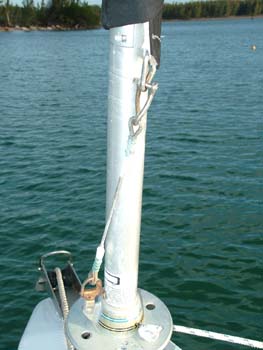 |
Web Page by Jim Faughn